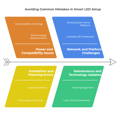Table of Contents
Introduction
Smart LEDs have revolutionized home lighting, offering unparalleled control, customization, and energy efficiency. According to a report by Statista, the global smart lighting market is projected to reach $46.88 billion by 2027. This boom in popularity makes it essential for electricians, installers, and other professionals to stay ahead of the curve and understand the nuances of smart LED integration. A poorly executed installation can lead to frustration for both the client and the installer, resulting in costly rework, diminished functionality, and damage to reputation. This article highlights the most common mistakes made during smart LED setup and provides valuable insights to ensure a smooth and successful integration process.
Overlooking Power Supply Requirements and Compatibility
Inconsistent or Incompatible LED Strip Types
Neglecting Proper Wiring and Connection Techniques
Ignoring Network Considerations for Seamless Control
Underestimating the Importance of a Well-Planned Layout


 Skip to content
Skip to content

